

Evidence Search - Search Engine for Evidence in Health and Social Care. Jointzone.org.uk. Interventions for ingrowing toenails. Almostadoctor.com - free medical student revision notes. Elsevier: Richards: Biomechanics in Clinic and Research Welcome. Episode 3: The Mechanics of Running Injury with Sports Podiatrist Ian Griffiths.
In this week’s Train Smarter podcast, we have an interview with sports podiatrist Ian Griffiths (@Sports_Pod).
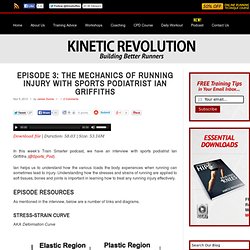
Ian helps us to understand how the various loads the body experiences when running can sometimes lead to injury. Understanding how the stresses and strains of running are applied to soft tissues, bones and joints is important in learning how to treat any running injury effectively. Episode Resources As mentioned in the interview, below are a number of links and diagrams. Stress-Strain Curve AKA Deformation Curve Image via: McPoil, TG. & Hunt GC. (1995) Evaluation and Management of Foot and Ankle Disorders: present Problems and Future Directions.
Further Reading These books by Kevin Kirby are a ‘must read’ for anybody wanting to delve further into these concepts in the context of the lower extremity. Jay Dicharry’s book Anatomy for Runners also has a great section discussing many of the points in today’s interview. Running Research Junkie Ian’s Website About The Author James Dunne. Education. We have compiled the most important orthotic therapy information and stored it in one place so it is available 24/7.
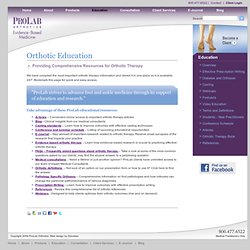
Bookmark this page for quick and easy access. "ProLab strives to advance foot and ankle medicine through its support of education and research. " Take advantage of these ProLab educational resources: Articles – Convenient online access to important orthotic therapy articles Blog - Clinical insights from our medical consultants Casting standards – Learn how to improve outcomes with effective casting techniques Conference and seminar schedule – Listing of upcoming educational opportunities E-Journal – Stay abreast of important research related to orthotic therapy. Practitioner - Cascade Dafo. Downloads. Tendinopathy – the importance of staging and role of compression. Written by Tom Goom, senior Physio at The Physio Rooms Brighton.

Follow Tom on Twitter. Tendon problems are common in runners and can become a persistent issue if not properly treated. In recent years our understanding of the pathology of tendinopathy has grown – we now know that it isn’t really an inflammatory process and that load plays a large role. We also know that it’s important to determine the ‘stage’ of the tendinopathy and this will have a huge influence on how you manage it. Jill Cook and Craig Purdam have been at the forefront of tendinopathy research for some years. Reactive tendinopathy typically involves the tendon responding to a rapid increase in loading. “A short term adaptation to overload that thickens the tendon, reduces stress and increases stiffness” Tendon dysrepair is usually the stage that would follow reactive tendinopathy if the tendon continues to be excessively loaded.
Podiatry Arena. Lab Tests Online-UK: Welcome! The Ultrasound Site. Foot and ankle taping. This blog contains 3 kinesiology tape techniques you can use with foot or ankle pain.
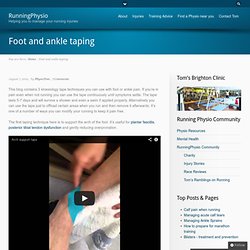
If you’re in pain even when not running you can use the tape continuously until symptoms settle. The tape lasts 5-7 days and will survive a shower and even a swim if applied properly. Alternatively you can use the tape just to offload certain areas when you run and then remove it afterwards. It’s one of a number of ways you can modify your running to keep it pain free. The first taping technique here is to support the arch of the foot. The second technique is to offload the Achilles which is especially useful in tendinopathy. Apologies if the video below isn’t clear, it’s hard to film it from an angle which shows everything.
This final technique is an alternative way of supporting the Achilles and can also be used for Tibialis Posterior. Iliotibial Band Syndrome. ITB.
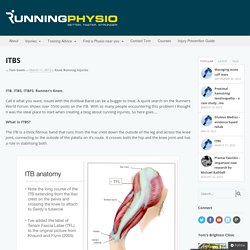
ITBS. ITBFS. Runner’s Knee. Call it what you want, issues with the Iliotibial Band can be a bugger to treat. A quick search on the Runner’s World Forum shows over 3500 posts on the ITB. What is ITBS? Patellofemoral Pain Syndrome - Runner's Knee. Patellofemoral Pain Syndrome (PFPS) is one of the most common and most challenging injuries a runner might face.
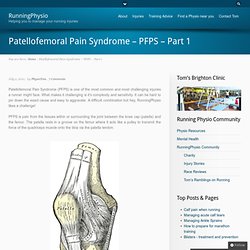
What makes it challenging is it’s complexity and sensitivity. It can be hard to pin down the exact cause and easy to aggravate. A difficult combination but hey, RunningPhysio likes a challenge! PFPS is pain from the tissues within or surrounding the joint between the knee cap (patella) and the femur. The patella rests in a groove on the femur where it acts like a pulley to transmit the force of the quadriceps muscle onto the tibia via the patella tendon. Picture from Gray’s Anatomy (1918) There is some debate as to what causes the pain in PFPS. Trade Secret: Proper Calf Raise We are selling... Technical Topics. Change Pain - PDP. Learning. Basic Biomechanics Courses and Learning Resources. Journal of Foot and Ankle Research.
Swift - for healthcare professionals. MSK:UK - MSK:UK. Mediasite Player.
FitzKidz - FitzKidz. PRESENT Courseware List. Henning Langberg: Professor at the Institute of Health University o...